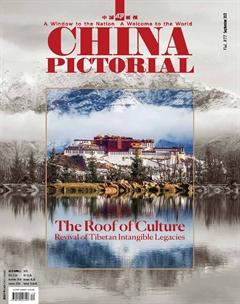Rural Revitalization in Nyingchi
by Xi Xi
China has invested heavily in rural revitalization. Launched in 2017, the rural revitalization plans main goals have been upgrading agriculture, developing rural areas, and providing locals with new jobs and business opportunities so that their income and living conditions can improve. It focuses on realms including culture, environment, industry, and skills training.
In Longgu Village, Zayu County of southwestern Chinas Tibet Autonomous Region, improving the living environment involved separating livestock from humans to ensure more hygienic conditions. Cows and other livestock now have a dedicated and easily accessible area in the village. They stay there during the winter season, but from May to October, the animals graze in a centralized pasture. Garbage treatment facilities have also been installed. Other new projects include raising local Tibetan chickens and livestock to increase villagers incomes. Their products can now be sold all over Zayu County thanks to the improved roads.
Suonam Wangmu, 29, was born and raised in Longgu Village. Always an outstanding student, she left to study in a boarding junior high school and then a college. Missing her family beckoned her back after college. She graduated from Minzu University of China in Beijing, but finding a good job or civil servant position in a big city was never her goal. She considers education a game-changer that enables her to see the world in new ways.
In Longgu Village, Wangmu specifically handles two duties: growing a specific type of mushroom called morel which is very suitable to the local climate and environment, and breeding Tibetan black pigs, a traditional husbandry practice in the village.
An important part of her job is actually translating. Since many local workers hail from other parts of Tibet, they can speak Tibetan but not the local dialect. As a local, Wangmu is versed in the dialect and can also speak fluent Tibetan and Mandarin. She also offers a Tibetan and Chinese language class every Thursday to improve village education. Most villages including Longgu now need talented professionals to oversee rural revitalization as well as doctors and teachers.
In the past, local people used to worry about having enough food to eat, a place to stay, and clothes to wear, but recent upturns have spurred major changes. Suonam Wangmu hopes that rural revitalization will further benefit the village and continue improving everyones life.
In Gongbogyamda County, rural revitalization has been mostly economic and tourism development. The 10 villages in Gongbogyamda are all involved with different types of projects: greenhouse planting, mushroom processing cooperatives, Tibetan black pig breeding, manual weaving, and tourism. To attract tourists, the local government has developed folk culture tourism and built a large hall for performing arts, a large cultural activity square, a tourist service center, and family hotels. Thanks to the rich natural resources of Gongbogyamda and strong emphasis on fruit and vegetable planting, traditional handicrafts and tourism, local villagers livelihoods and incomes have already increased substantially.
Losang Tseji, 25, was born in Lalong Village, Gongbogyamda Town. After finishing college in Changsha, central Chinas Hunan Province, she returned to her hometown in 2020 with the aim of contributing to local development. Securing a good job in her village allowed her to stay there close to her parents, which was particularly important for her.
In recent years, she has been able to witness the improvements in the areas villages: Most families now live in more spacious and brighter houses, grow a wide variety of fruits and vegetables, and own a car with which they can enjoy the convenience of the recently paved roads. Tseji believes that the village will continue developing in the coming years, and she looks forward to even more improvements to the local economy and living standards. The villagers put a lot of trust in the program as well. Under the poverty alleviation plan, strong support has been given to seniors and registered poor households. Tseji called rural revitalization an ideal continuation to solidify the key achievements of poverty alleviation and take the results further through new sustainable projects.
More and more villages in the Tibet Autonomous Region and other parts of China are gradually seeing the results of the rural revitalization plan which has been making the countryside more attractive to urbanites. Although many young people still prefer to take their chances in big cities, many others are taking a hard look at going back home for good. According to several villagers, more and more young people have been keen on settling down in their home village or coming back after a few years in other parts of China. The future of rural life in China seems brighter and brighter.

